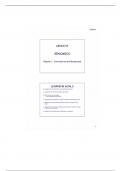1
Deception in Clinical Settings
PSB3E-M13
Dr. A.B.M. Fuermaier
,2
Index
LECTURE 1: Introduction (p. 3 – 9)
Rogers, R. & Bender, S.D. (2018). Clinical assessment of malingering and deception (4th
edition). New York: Guilford Press.
- Chapter 1: An introduction to response styles (R. Rogers), pp. 3 – 17. Link
Rogers, R. & Bender, S.D. (2018). Clinical assessment of malingering and deception (4th
edition). New York: Guilford Press.
- Chapter 5: Syndromes associated with deception (M. Vitacco), pp. 83 – 97. Link
LECTURE 2: Factitious disorders and Munchausen syndrome by proxy (p. 10 – 21)
Rogers, R. & Bender, S.D. (2018). Clinical assessment of malingering and deception (4th
edition). New York: Guilford Press.
- Chapter 11: Factitious disorders in medical and psychiatric practices (G. Yates, M.
Mulla, J. Hamilton, M. Feldman), pp. 212 - 235. Link
Day, D.O., & Moseley, R.L. (2010). Munchausen by proxy syndrome. Journal of Forensic
Psychology Practice, 10, 13-36. Link
LECTURE 3: Malingering of cognitive dysfunctions and psychiatric disorders I. (p. 22 – 28)
Carone, D.A., Iverson, G.L., & Bush, S.S. (2010). A model to approaching and providing
feedback to patients regarding invalid test performance in clinical neuropsychological
evaluations. The Clinical Neuropsychologist, 24, 759-778. Link
Rogers, R. & Bender, S.D. (2018). Clinical assessment of malingering and deception (4th
edition). New York: Guilford Press.
- Chapter 13: Feigned medical presentations (R. Granacher, D. Berry), pp. 243 - 253.
Link
LECTURE 4: Malingering of cognitive dysfunctions: Amnesia (p. 29 – 33)
Rogers, R. & Bender, S.D. (2018). Clinical assessment of malingering and deception (4th
edition). New York: Guilford Press.
- Chapter 20: Recovering memories of childhood sexual abuse (R. McNally), pp. 387-
400. Link
LECTURE 5: Validity testing in child and adolescent assessment (p. 34 – 42)
Kirkwood, M. (2015). Validity testing in child and adolescent assessment. New York:
Guilford Press. - Chapter 1: A rationale for performance validity testing in child and
adolescent assessment (Michael Kirkwood), pp. 3 – 21. Link
Kirkwood, M. (2015). Validity testing in child and adolescent assessment. New York:
Guilford Press. - Chapter 6: Clinical strategies to assess the credibility of presentations in
children (Dominic Carone), pp. 107 – 124. Link
Kirkwood, M. (2015). Validity testing in child and adolescent assessment. New York:
Guilford Press. - Chapter 7: Motivations behind noncredible presentations: Why children
feign and how to make this determination (David Baker and Michael Kirkwood), pp. 125 –
144. Link
LECTURE 6: Residual effects of malingering (Dr. Isabella Niesten) (p. 43 – 45)
Merckelbach, H., Jelicic, M., & Pieters, M. (2011). The residual effect of feigning: How
intentional faking may evolve into a less conscious form of symptom reporting. Journal of
Clinical and Experimental Neuropsychology, 33(1), 131-139, Link
LECTURE 7: (p. 46 – 53)
Topic 1: A case report on malingered amnesia (Dr. Isabella Niesten, ONLINE via
Blackboard)
Topic 2: Polygraph
Rogers, R. & Bender, S.D. (2018). Clinical assessment of malingering and deception (4th
edition). New York: Guilford Press.
- Chapter 19: Assessing deception: Polygraph techniques and integrity testing (W.G.
Iacono & C.J. Patrick), pp. 361-386. Link
,3
Clinical Assessment of Malingering and Deception – Rogers & Bender (Book)
Lecture 1
Chapter 1: An introduction to response styles
- Clients: minimise distress, symptom severity, pretend to like comments/suggests of therapist,
overstating effectiveness of therapy, pretending to do homework etc.
- Intimate relationship: partners have varying degrees of self-disclosure and usually think they
are better at deceiving the other.
- Workplace: non-disclosing mental disorders out of fear of job security and stigma.
- Concealable stigmas: part of impression management. Basically, what you disclose and what
not across various social contexts
- Lexogenic effects: clients’ reaction when their credibility is implicitly questioned
- Some clinicians only record consequential deceptions and distortions.
o Using the Evaluation of Competency to Stand Trial-Revised (ECST-R)
- Issue with inconsequential deceptions:
1. Taint hypothesis: nongenuine responding as an indication of presently undetected
dissimulation (person pretending).
2. Beyond-reasonable-doubt standard: only conclusive evidence of a response style
should be reported (e.g., feigning).
- Clinicians’ decision of which evidence to include in a forensic report:
1. Accuracy versus completeness of clinicians’ conclusion
2. Use versus misuse of clinical findings by others
Fundamentals of Response Styles:
Basic Concepts and Definitions Nonspecific Terms
- Important because: Often mis-categorization of criminal offenders due to their manipulative
behaviour. Now, nonspecific terms allow for a general description
- Should be used when there is insufficient evidence for a specific term
o Unreliability: questions accuracy of reported information; no assumption about
individuals’ intent.
o Nondisclosure: withholding information; no assumptions about intent.
o Self-disclosure: high when high degree of openness; important in reciprocal
relationships.
o Deception: any consequential attempt to distort or misrepresent self-reporting;
includes deceit and nondisclosure.
o Dissimulation: range of deliberate distortions or misrepresentations of psychological
symptoms; practically helpful for clinicians
Overstated Pathology
1. Malingering: “the intentional production of false or grossly exaggerated physical or
psychological symptoms, motivated by external incentives”; magnitude is important here, so
that it includes multiple symptoms and gross exaggeration; also, external incentive is not
required, there are also internal motivations.
2. Factitious presentations: “intentional production or feigning” of symptoms motivated by
wanting a “sick role”; there must be no external reward present.
3. Feigning: deliberate fabrication or gross exaggeration of psychological or physical
symptoms, without any assumptions about its goals; can be tested.
- Three terms to be avoided:
1. Suboptimal effort: misused for malingering; lacks precision; “best effort” may be affected
by variety of internal and external factors.
2. Overreporting: unexpectedly high level of item endorsement; “Self-unfavourable
reporting”; lacks clarity.
3. Secondary gain: conflicting meanings in psychodynamic perspective (unconscious
process), behavioural medicine (social context), and forensic perspective (use illness for
gain).
, 4
Simulated Adjustment
1. Defensiveness: opposite of malingering; refers to deliberate denial or minimization of
symptoms; refers mainly to the concealment of psychological impairment.
2. Social desirability: tendency to present self in most favourable manner relative to the social
norms; involves denial of neg characteristics as well as pos.
3. Impression management: deliberate efforts to control others’ perceptions of an individual;
more situationally driven; such as hyper-competitiveness or “playing dumb”.
Other Response Styles
1. Irrelevant responding: individual not psychologically engaged in the assessment process;
given responses are not necessarily related to the clinician’s question; maybe disengagement
or carelessness; patterns may emerge.
2. Random responding: subset of irrelevant responding because based on chance factors.
3. Acquiescent responding: “yea-saying”.
4. Disacquiescent responding: “nay-saying”.
5. Role assumption: playing a role while answering; poorly understood.
6. Hybrid responding: more than one response style in one situation.
Domains of Dissimulation:
- Response styles are not pervasive.
o Might change depending on domain (mental disorders, cognitive abilities, medial
complaints)
Common Misconceptions about Malingering
Malingering is rare
Malingering is a static response style: “once a malingerer, always a malingerer” false!
Usually depends on context
Malingering is an antisocial act by an antisocial person
Deception is evidence of malingering: malingering is NOT lying
Malingering is like the iceberg phenomenon: like the taint hypothesis; false assumption that
any observable feigning is part of the metaphorical “tip of the iceberg”.
Malingering precludes genuine disorders
Syndrome-specific feigning scales measure syndrome-specific malingering
Malingering has stable base rates
Clinical and Research Models:
Motivational Basis of Response Styles
- Explanatory models: including the motivational basis for response styles.
- Simulated adjustment: encompasses defensiveness, impression management, social
desirability
o E.g., minimisation of suicidal ideation maintaining a positive image & minimise
social sanctions
- Self-focused utilities: e.g., man hiding depression to avoid appearing weak.
o Can be deliberate of unconscious
- Research: malingerers engage in a cost-benefit analysis in choosing to feign impairment; two
other explanatory models:
1. Psychodynamic: an underlying disorder motivated the malingerer; prediction of
further deterioration (no evidence)
2. Criminological: malingering is typically seen as an antisocial act that is likely to
be committed by antisocial persons; poor evidence.
Problem with criminological model: relies on common (≠ distinguishing)
characteristics of malingering
- Predominant predicted-utility model: simulators maximise their utility by using:
o overstated pathology, and






